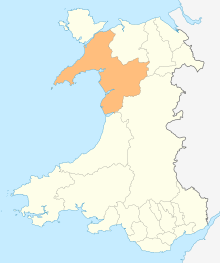Caernarfon
Caernarfon (/kərˈnɑːrvən/; Welsh: [kaɨrˈnarvɔn] (![]()
| Caernarfon | |
|---|---|
.jpg) Caernarfon Castle and quayside with Snowdonia in the distance | |
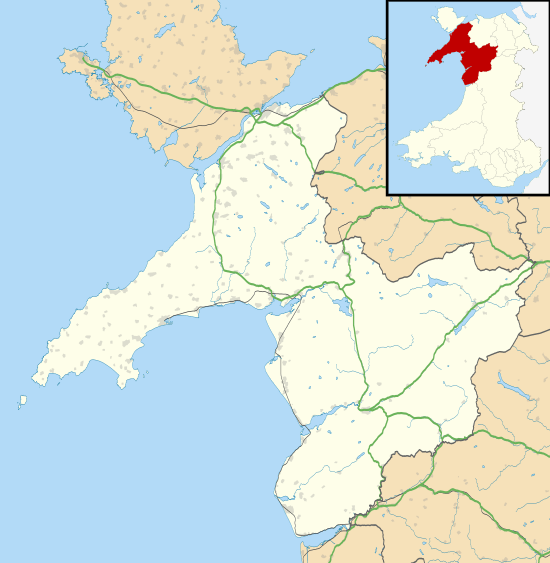 Caernarfon Location within Gwynedd | |
| Population | 9,852 (2011)[1] |
| OS grid reference | SH485625 |
| • Cardiff | 171 mi (275 km) |
| Community |
|
| Principal area | |
| Ceremonial county | |
| Country | Wales |
| Sovereign state | United Kingdom |
| Post town | CAERNARFON |
| Postcode district | LL54, LL55 |
| Dialling code | 01286 |
| Police | North Wales |
| Fire | North Wales |
| Ambulance | Welsh |
| UK Parliament | |
| Senedd Cymru – Welsh Parliament | |
Abundant natural resources in and around the Menai Strait enabled human habitation in prehistoric Britain. The Ordovices, a Celtic tribe, lived in the region during the period known as Roman Britain. The Roman fort Segontium was established around AD 80 to subjugate the Ordovices during the Roman conquest of Britain. The Romans occupied the region until the end of Roman rule in Britain in 382, after which Caernarfon became part of the Kingdom of Gwynedd. In the late 11th century, William the Conqueror ordered the construction of a motte-and-bailey castle at Caernarfon as part of the Norman invasion of Wales. He was unsuccessful, and Wales remained independent until around 1283.
In the 13th century, Llywelyn ap Gruffudd, ruler of Gwynedd, refused to pay homage to Edward I of England, prompting the English conquest of Gwynedd. This was followed by the construction of Caernarfon Castle, one of the largest and most imposing fortifications built by the English in Wales. In 1284, the English-style county of Caernarfonshire was established by the Statute of Rhuddlan; the same year, Caernarfon was made a borough, a county and market town, and the seat of English government in north Wales.[2]
The ascent of the House of Tudor to the throne of England eased hostilities between the English and resulted in Caernarfon Castle falling into a state of disrepair. The town has flourished, leading to its status as a major tourist centre and seat of Gwynedd Council, with a thriving harbour and marina. Caernarfon has expanded beyond its medieval walls and experienced heavy suburbanisation. The community of Caernarfon's population includes the highest percentage of Welsh-speaking citizens anywhere in Wales.[3] The status of Royal Borough was granted by Queen Elizabeth II in 1963 and amended to Royal Town in 1974.[4] The castle and town walls are part of a World Heritage Site described as the Castles and Town Walls of King Edward in Gwynedd.
History

The present city of Caernarfon grew up around and owes its name to its Norman and late Medieval fortifications.[5] The earlier British and Romano-British settlement at Segontium was named for the nearby Afon Seiont. After the end of Roman rule in Britain around 410, the settlement continued to be known as Cair Segeint ("Fort Seiont") and as Cair Custoient ("Fort Constantius or Constantine"),[6] of the History of the Britons, cited by James Ussher in Newman's life of Germanus of Auxerre, both of whose names appear among the 28 civitates of sub-Roman Britain in the Historia Brittonum traditionally ascribed to Nennius. The work states that the inscribed tomb of "Constantius the Emperor" (presumably Constantius Chlorus, father of Constantine the Great) was still present in the 9th century.[7] (Constantius actually died at York; Ford credited the monument to a different Constantine, the supposed son of Saint Elen and Magnus Maximus, who was said to have ruled northern Wales before being removed by the Irish.[8]) The medieval romance about Maximus and Elen, Macsen's Dream, calls her home Caer Aber Sein ("Fort Seiontmouth" or "the caer at the mouth of the Seiont") and other pre-conquest poets such as Hywel ab Owain Gwynedd also used the name Caer Gystennin.[9]

The Norman motte was erected apart from the existing settlement and came to be known as y gaer yn Arfon, "the fortress in Arfon". (The region of Arfon itself derived its name from its position opposite Anglesey, known as Môn in Welsh.)[10] A 1221 charter by Llywelyn the Great to the canons of Penmon priory on Anglesey mentions Kaerinarfon;[11] the Brut mentions both Kaerenarvon and Caerenarvon.[12] In 1283, King Edward I completed his conquest of Wales which he secured by a chain of castles and walled towns. The construction of a new stone Caernarfon Castle seems to have started as soon as the campaign had finished.[13] Edward's architect, James of St. George, may well have modelled the castle on the walls of Constantinople, possibly being aware of the town's legendary associations. Edward's fourth son, Edward of Caernarfon, later Edward II of England, was born at the castle in April 1284 and made Prince of Wales in 1301. A story recorded in the 16th century suggests that the new prince was offered to the native Welsh on the premise "that [he] was borne in Wales and could speake never a word of English", however there is no contemporary evidence to support this.[14]
Caernarfon was constituted a borough in 1284 by charter of Edward I.[15] The charter, which was confirmed on a number of occasions, appointed the mayor of the borough Constable of the Castle ex officio.[16] The former municipal borough was designated a royal borough in 1963.[15] The borough was abolished by the Local Government Act 1972 in 1974, and the status of "royal town" was granted to the community which succeeded it.[15] Caernarfon was the county town of the historic county of Caernarfonshire.
In 1911, David Lloyd George, then Member of Parliament for Caernarfon boroughs, which included various towns from Llŷn to Conwy, agreed to the British Royal Family's idea of holding the investiture of the Prince of Wales at Caernarfon Castle. The ceremony took place on 13 July, with the royal family visiting Wales, and the future Edward VIII was duly invested.
In 1955 Caernarfon was in the running for the title of Capital of Wales on historical grounds but the town's campaign was heavily defeated in a ballot of Welsh local authorities, with 11 votes compared to Cardiff's 136.[17] Cardiff therefore became the Welsh capital.
.jpg)
On 1 July 1969 the investiture ceremony for Charles, Prince of Wales was again held at Caernarfon Castle. The ceremony went ahead without incident despite terrorist threats and protests, which culminated in the death of two members of Mudiad Amddiffyn Cymru (Welsh Defence Movement), Alwyn Jones and George Taylor, who were killed when their bomb – intended for the railway line at Abergele in order to stop the British Royal Train – exploded prematurely. The bomb campaign (one in Abergele, two in Caernarfon and finally one on Llandudno Pier) was organised by the movement's leader, John Jenkins. He was later arrested after a tip-off and was sentenced to ten years' imprisonment.[18]
In July 2019 Caernarfon hosted a rally for Welsh independence. The event, organised by AUOB (All Under One Banner) Cymru, included a march through the town centre. Organisers estimated that roughly 8,000 people joined on the march on the town square; local authorities confirmed at least 5,000 attendees.[19] The event featured a number of speakers including Hardeep Singh Kohli, Evra Rose, Dafydd Iwan, Lleuwen Steffan, Siôn Jobbins, Beth Angell, Gwion Hallam, Meleri Davies and Elfed Wyn Jones. Talks covered criticism of Brexit and Westminster with advocating Welsh Independence.[20]
The history of Caernarfon, as an example where the rise and fall of different civilizations can be seen from one hilltop, is discussed in John Michael Greer's book The Long Descent. He writes of Caernarfon:
Spread out below us in an unexpected glory of sunlight was the whole recorded history of that little corner of the world. The ground beneath us still rippled with earthworks from the Celtic hill fort that guarded the Menai Strait more than two and a half millennia ago. The Roman fort that replaced it was now the dim brown mark of an old archeological site on low hills off to the left. Edward I’s great gray castle rose up in the middle foreground, and the high contrails of RAF jets on a training exercise out over the Irish Sea showed that the town’s current overlords still maintained the old watch. Houses and shops from more than half a dozen centuries spread eastward as they rose through the waters of time, from the cramped medieval buildings of the old castle town straight ahead to the gaudy sign and sprawling parking lot of the supermarket back behind us.
Geography
Caernarfon is situated on the southern bank of the Menai Strait facing the Isle of Anglesey. It is situated 8.6 miles (13.8 km) south-west of Bangor, 19.4 miles (31.2 km) north of Porthmadog and approximately 8.0 miles (12.9 km) west of Llanberis and Snowdonia National Park.[21] The mouth of the River Seiont is in the town, creating a natural harbour where it flows into the Menai Strait. Caernarfon Castle stands at the mouth of the river.[22] The A487 passes directly through Caernarfon, with Bangor to the north and Porthmadog to the south.
As the crow flies, the summit of Snowdon lies a little over 9.6 miles (15.4 km) to the southeast of the town centre.
Economy
Caernarfon's historical prominence and landmarks have made it a major tourist centre.[23] As a result, many of the local businesses cater for the tourist trade. Caernarfon has numerous guest houses, inns and pubs, hotels, restaurants and shops. The majority of shops in the town are located either in the centre of town around Pool Street and Castle Square (Y Maes), or on Doc Fictoria (Victoria Dock). A number of shops are also located within the Town Walls.
The majority of the retail and residential section of Doc Fictoria was opened in 2008. The retail and residential section of Doc Fictoria is built directly beside a Blue Flag beach marina. It contains numerous homes, bars and bistros, cafés and restaurants, an award-winning arts centre, a maritime museum and a range of shops and stores.[24]
Pool Street and Castle Square contain a number of large, national retail shops and smaller independent stores. Pool Street is pedestrianised[25] and serves as the town's main shopping street. Castle Square, commonly referred to as the 'Maes' by both Welsh and English speakers, is the market square of the town. A market is held every Saturday throughout the year and also on Mondays in the summer.[26] The square was revamped at a cost of £2.4 million in 2009. However, since its revamp the square has caused controversy due to traffic and parking difficulties. During the revamp, it was decided to remove barriers between traffic and pedestrians creating a 'shared space', to try and force road users to be more considerate of pedestrians and other vehicles. This is the first use of this kind of arrangement in Wales, but it has been described by councillor Bob Anderson as being 'too ambiguous' for road users.[27] Another controversy caused by the revamp of the Maes was that a historic old oak tree was taken down from outside the HSBC bank. When the Maes was re-opened in July 2009 by the local politician and Heritage Minister of Wales, Alun Ffred Jones AM, he said, "the use of beautiful local slate is very prominent in the new Maes."
There are many old public houses serving the town, including The Four Alls (that has recently had a £500,000 renovation), The Anglesey Arms Hotel, The Castle Hotel, The Crown, Morgan Lloyd, Pen Deitch and The Twthill Vaults. The oldest public house in Caernarfon is the Black Boy Inn, which remained in the same family for over 40 years until sold in 2003 to a local independent family business. The pub has stood inside Caernarfon's Town Walls since the 16th century, and many people claim to have seen ghosts within the building.[28]
In and around the Town Walls are numerous restaurants, public houses and inns, and guest houses and hostels.[29]
Local government
Gwynedd Council's head offices are situated in the town. The local court serves the town and the rest of north-west Wales, and in 2009 moved to a multimillion-pound court complex on Llanberis Road. The Caernarfon parliamentary constituency was a former electoral area centred on Caernarfon. Caernarfon is now part of the Arfon constituency for both the UK Parliament and the Senedd. The town is twinned with Landerneau in Brittany.[30]
At the local level, Caernarfon Royal Town Council comprises 17 town councillors, elected from the wards of Cadnant (4), Menai (4), Peblig (5) and Seiont (4).[31]
Demography
The population in 1841 was 8,001.[32]
The population of Caernarfon Community Parish in 2001 was 9,611.[33] Caernarfon residents are known colloquially as "Cofis". The word "Cofi" /ˈkɒvi/ is also used locally in Caernarfon to describe the local Welsh dialect, notable for a number of words not in use elsewhere.
Within Wales, Gwynedd has the highest proportion of speakers of the Welsh language. The greatest concentration of Welsh speakers in Gwynedd is found in and around Caernarfon.[34] According to the 2001 Census, 86.1% of the population could speak Welsh; the largest majority of Welsh speakers was found in the 10-14 age group, where 97.7% could speak it fluently. The town is nowadays a rallying-point for the Welsh nationalist cause.
Landmarks
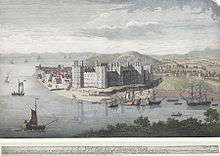

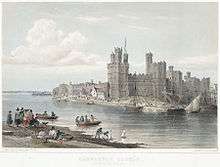
Caernarfon Castle
The present castle building was constructed between 1283 and 1330 by order of King Edward I. The banded stonework and polygonal towers are thought to have been in imitation of the Walls of Constantinople. The impressive curtain wall with nine towers and two gatehouses survive largely intact. Caernarfon Castle is now under the care of Cadw and is open to the public. The castle includes the regimental museum of the Royal Welch Fusiliers.
Caernarfon town walls
The medieval town walls, including eight towers and two twin-towered gateways form a complete circuit of 800 yards (730 m) around the old town and were built between 1283 and 1285.[35] The walls are in the care of Cadw but only a small section is accessible to the public. The town walls and castle at Caernarfon were declared part of a World Heritage Site in 1986.[36] According to UNESCO, the castle and walls together with other royal castles in Gwynedd "are the finest examples of late 13th century and early 14th century military architecture in Europe".[37]
Church of St Peblig
Dedicated to Saint Peblig, the son of Saint Elen and Macsen Wledig (Magnus Maximus), the church is built on an important early Christian site, itself built on a Roman Mithraeum or temple of Mithras, close to the Segontium Roman Fort. A Roman altar was found in one of the walls during 19th century restoration work. The present church dates mainly from the 14th century and is a Grade I listed building.[38]
Statue of David Lloyd George
The statue in Castle Square was sculpted by W. Goscombe John and was erected in 1921 when Lloyd George was Prime Minister. David Lloyd George was the Member of Parliament for the area from 1890 to 1945.[39]
The Old Market Hall
The Old Market Hall in Hole-in-the-Wall Street and Crown Street was built in 1832, but the interior and roof were rebuilt later in that century. It is a Grade II listed building.[40] It now acts as a pub and music venue.
Others
The old County Hall, which went on to become a courthouse, is situated inside the castle walls, next door to the Anglesey Arms Hotel. The old courthouse is built in the Neo-classical style. The courthouse was replaced in 2009 by a new complex designed by HOK on the former Segontium School site in Llanberis Road.[41] The old courthouse adjoins what used to be Caernarfon Gaol, which has been closed since the early 20th century and was subsequently converted into council offices.[42]
There is a small hospital in the town, 'Ysbyty Eryri' (i.e. "Snowdonia Hospital"). The nearest large regional hospital is Ysbyty Gwynedd, in Bangor.[43]
Previously, Caernarfon had been chosen as the location of a new prison. HMP Caernarfon would have held up to 800 adult males when constructed, and would have taken prisoners from all over the North Wales area. However, in September 2009 the UK Government withdrew plans to construct the prison.[44]
Caernarfon Barracks were commissioned by John Lloyd, County Surveyor of Caernarfonshire, as a military headquarters and completed in 1855.[45]
Transport
Sea
Caernarfon was at one time an important port, exporting slate from the Dyffryn Nantlle quarries. This traffic was facilitated from 1828 by the Nantlle Railway which predated far more widely known ventures such as the Liverpool and Manchester Railway and the Ffestiniog Railway.
Rail
Five passenger stations have served the town:
Caernarvon railway station opened in 1852 as the western terminus of the Bangor and Carnarvon Railway. This connected the town with the North Wales coast and the expanding national network.
Carnarvon Castle railway station opened in 1856 as the northern passenger terminus of the narrow gauge Nantlle Railway. This service ended in 1865 when the line being built from the south by the standard gauge Carnarvonshire Railway took over most of its trackbed. The Carnarvonshire Railway's temporary northern terminus was at Pant to the south of the town. Pant station opened in 1867.
At the same time the Carnarvon and Llanberis Railway built its line from Llanberis to Caernarfon. Its temporary western terminus was called Carnarvon (Morfa). It opened in 1869 near the modern road bridges over the Afon Seiont.
For a short period, therefore, Caernarfon had three terminating stations on its edges. Records are contradictory, but this ended in either 1870 or 1871 when they were connected by a line through the town using the tunnel which survives, having been converted in 1995 for road traffic. When the through route was opened Pant and Morfa stations closed and the original station became the town's only station. The London and North Western Railway also took over all the lines mentioned leaving one station and one service provider by 1871.
The services to Llanberis and south to Afon Wen closed progressively from the 1930s, with tracks being lifted in the mid-1960s, but Caernarvon station survived until 1970, becoming one of the last passenger services to be closed under the Beeching Axe; it is now the site of a Morrisons supermarket.
The fifth station was opened on the old trackbed in St. Helen's Road. It is the northern terminus of the narrow gauge Rheilffordd Eryri / Welsh Highland Railway. Work began on a permanent station for the town in February 2017. The new station opened to passengers in Spring 2019. Heritage steam services provide links to Porthmadog, where passengers can change for services on the Ffestiniog Railway to Blaenau Ffestiniog.[46]
Bus
Bus services in the town are provided by Arriva Buses Wales, and a number of smaller, local operators. Longer distance, cross country services are operated by Lloyds Coaches, and connect the town with Bangor to the north, and Aberystwyth via Porthmadog, Dolgellau and Machynlleth to the south. These services are part of the Welsh Government funded TrawsCymru network.
Road
The A487 trunk road bisects the town, providing access to major urban areas along the North Wales coast and the Port of Holyhead, via the A55 expressway. Llanberis at the foot of Snowdon can be reached via the A4086, which heads east out of the town towards Capel Curig.
Bike
Heading north out of the town is the Lôn Las Menai cycle path to nearby Y Felinheli. Heading south out of the town is the Lôn Eifion cycle path, which leads to Bryncir, near Criccieth. The route provides views into the Snowdonia mountains, down along the Llŷn Peninsula and across to the Isle of Anglesey.[47]
Air
Caernarfon Airport is 4.5 miles (7.2 km) to the south west, and offers pleasure flights and an aviation museum.[48]
Foot
The Aber Swing Bridge is a pedestrian swing bridge that crosses over the Afon Seiont to connect pedestrians from the foreshore to the Watergate entrance in the centre of Caernarfon by the Caernarfon Castle.
Education
There are four primary schools in Caernarfon, Ysgol yr Hendre being the largest. The others are Ysgol y Gelli, Ysgol Santes Helen and Ysgol Maesincla.
The single secondary school serving Caernarfon and the surrounding areas – Ysgol Syr Hugh Owen – currently has between 900 and 1000 pupils from ages 11 to 18.
Ysgol Pendalar is a school for children with special needs.
Coleg Menai is a further education college for adult learners.
Notable people
- See Category: People from Caernarfon
Sport
Caernarfon Town Football Club (Welsh: Clwb Pêl Droed Tref Caernarfon) is a Welsh football club based in the town, which currently plays in the Cymru Premier, the top level for football in Wales. The club is nicknamed "the Canaries" because of its yellow and green strip, a nickname that dates from 1895. Caernarfon Town plays at The Oval which has a capacity of 3000 people and 250 seated people.
Culture
Caernarfon hosted the National Eisteddfod in 1862, 1894, 1906, 1921, 1935, 1959 and 1979. Unofficial National Eisteddfod events were also held there in 1877 and 1880. Caernarfon also hosted the 30th annual Celtic Media Festival in March 2009.
Cultural destinations include Galeri and Oriel Pendeitsh.
Galeri is a creative enterprise centre that houses a gallery, a concert hall, cinema, a number of companies, and a range of other creative and cultural spaces.
Oriel Pendeitsh is a ground-floor exhibition space adjoining the Tourist Information Centre opposite Caernarfon Castle. The gallery has a varied and changing programme of exhibitions throughout the year.
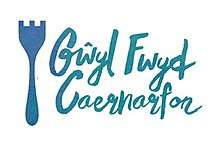
The Caernarfon Food Festival, a food festival began in 2016 and occurs annually.[49][50]
Freedom of the Town
The following people and military units have received the Freedom of the Town of Caernarfon.
Individuals
References
- "Town population 2011". Archived from the original on 23 September 2015. Retrieved 15 May 2015.
- Gareth Edwards. "Caernarfon Tourist Information". Visitcaernarfon.com. Archived from the original on 5 October 2013. Retrieved 29 September 2012.
- "2011 Census results by Community". Welsh Language Commissioner. Welsh Language Commissioner. Archived from the original on 14 September 2017.
- "BBC News - How does a town get a 'royal' title?". Bbc.co.uk. 17 March 2011. Retrieved 29 September 2012.
- Allen, Grant. "Casters and Chesters" in The Cornhill Magazine, Vol. XLV, pp. 419 ff. Smith, Elder, & Co. (London), 1882.
- Stevenson's 1838 edition, P. 20.
- Newman, John Henry & al. Lives of the English Saints: St. German, Bishop of Auxerre, Ch. X: "Britain in 429, A. D.", p. 92. Archived 21 March 2016 at the Wayback Machine James Toovey (London), 1844.
- Ford, David Nash. "The 28 Cities of Britain Archived 15 April 2016 at the Wayback Machine" at Britannia. 2000.
- William, Ifor. Breuddwyd Maxen. (Bangor), 1920.
- Taylor 1997, p. 4
- Jones, Thomas (ed.). Brut y Tywysogion[:] Peniarth MS. 20. (Cardiff), 1941.
- Taylor, Arnold (1997) [1953], Caernarfon Castle and Town Walls (4th ed.), Cardiff: Cadw – Welsh Historic Monuments, ISBN 1-85760-042-8
- Phillips, Seymour (2006). "The Place of the Reign of Edward II". In Dodd, Gwilym; Musson, Anthony, The Reign of Edward II: New Perspectives, Woodbridge, UK: York Medieval Press. pp. 220–233. ISBN 978-1-903153-19-2
- Davies, M. Lloyd (19 January 2009). "Caernarfon; Caernarvon". Coflein. Royal Commission on the Ancient and Historical Monuments of Wales. Retrieved 6 October 2012.
- "Cyngor Tref Frenhinol Caernarfon Royal Town Council". Caernarfontowncouncil.gov.uk. Archived from the original on 18 October 2012. Retrieved 29 September 2012.
- "INVESTING IN CAERNARFON". Property Investors Wales. Archived from the original on 1 July 2016. Retrieved 4 July 2012.
- "Parade to commemorate the Abergele Martyrs". Dailypost.co.uk. Retrieved 29 September 2012.
- "Thousands march for Welsh independence". 27 July 2019. Retrieved 3 September 2019.
- Evans, Harri (27 July 2019). "Independence march in Caernarfon sparks polarised reaction on social media". northwales. Retrieved 3 September 2019.
- "Google Maps". Google Maps. 1 January 1970. Retrieved 7 September 2012.
- "Caernarfon Castle". Snowdoniaguide.com. Retrieved 29 September 2012.
- Gareth Edwards. "Caernarfon Tourist Information". Visitcaernarfon.com. Retrieved 29 September 2012.
- "Doc Fictoria Victoria Dock Caernarfon". Docfictoria.co.uk. Archived from the original on 20 February 2012. Retrieved 29 September 2012.
- Your name (14 February 2011). "View a photo in the Photomap » Rising bollards, Pool St, Caernarfon (photo #28490)". CycleStreets. Retrieved 29 September 2012.
- "Caernarfon Market, a Market in Caernarfon, North Wales. Search for North Wales Markets". Information-britain.co.uk. 16 October 2005. Retrieved 29 September 2012.
- "Controversy over y Maes in Caernarfon". Caernarfon Herald. Retrieved 29 September 2012.
- "History :: Black Boy Inn | Caernarfon Hotels | Accommodation North Wales". Black Boy Inn. Retrieved 29 September 2012.
- Things to Do. "Things to Do". Caernarfon Hotels. Archived from the original on 29 January 2011. Retrieved 29 September 2012.
- Alun, Wena (20 January 2012). "BBC News - Town twinning links remain strong in Wales". Bbc.co.uk. Retrieved 29 September 2012.
- "Councillors". Caernarfon Royal Town Council. Retrieved 19 April 2019.
- The National Cyclopaedia of Useful Knowledge, Vol.III, London, 1847, Charles Knight, p.1,015
- Neighbourhood Statistics. "Check Browser Settings". Neighbourhood.statistics.gov.uk. Retrieved 29 September 2012.
- "Focus on Gwynedd - Gwynedd County Council" (PDF). Gwynedd.gov.uk. Archived from the original (PDF) on 1 October 2011. Retrieved 14 August 2012.
- "Caernarfon Town Wall, Caernarfon". www.britishlistedbuildings.co.uk. British Listed Buildings. Retrieved 13 November 2015.
- "Caernarfon Town Walls". cadw.gov.wales. Cadw Office, Welsh Government. Retrieved 13 November 2015.
- "Castles and Town Walls of King Edward in Gwynedd". whc.unesco.org. UNESCO World Heritage Centre. Retrieved 17 November 2015.
- "Church of St Peblig, Caernarfon". www.britishlistedbuildings.co.uk. British Listed Buildings. Retrieved 13 November 2015.
- "Statue of David Lloyd George, Caernarfon". www.britishlistedbuildings.co.uk. British Listed Buildings. Retrieved 13 November 2015.
- "The Old Market, Caernarfon". www.britishlistedbuildings.co.uk. British Listed Buildings. Retrieved 13 November 2015.
- "New Courts at Caernarfon". www.caernarfononline.co.uk. 13 July 2006. Archived from the original on 25 July 2011. Retrieved 8 February 2010.
- "Caernarfon Gaol; Old Prison Buildings; Council Offices". Coflein. Retrieved 20 October 2019.
- "NHS Facilities (Gwynedd)". Hansard. 22 April 1985. Retrieved 28 February 2019.
- "Plans for town prison are dropped". BBC News. 22 September 2009. Retrieved 28 April 2010.
- "Caernarfon Barracks". British Listed Buildings. Retrieved 21 August 2016.
- "£2m Caernarfon steam railway station work begins". BBC News. 5 February 2017. Retrieved 6 February 2017.
- "List Page". Discover Gwynedd. Archived from the original on 18 November 2012. Retrieved 29 September 2012.
- "index". Caernarfonairport.co.uk. Archived from the original on 5 October 2012. Retrieved 29 September 2012.
- Rieder, Duncan (11 May 2019). "Caernarfon Food Festival welcomes thousands of foodies for a whole host of treats". North Wales Chronicle. Retrieved 15 May 2020.
- "About Us". Caernarfon Food Festival. 14 May 2016. Retrieved 15 May 2020.
- Post, North Wales Daily (23 April 2009). "Royal Welsh to receive freedom of Flintshire and Caernarfon".
- CaernarfonOnline (25 April 2009). "Royal Welsh Freedom of The Royal Town of Caernarfon" – via YouTube.
Further reading
- Taylor, Arnold (1997) [1953]. Caernarfon Castle and Town Walls (4th ed.). Cardiff: Cadw – Welsh Historic Monuments. ISBN 1-85760-042-8.CS1 maint: ref=harv (link)
- Caernarfon Waterfront: Understanding Urban Caracter, published by Cadw, 2010
External links
| Wikimedia Commons has media related to Caernarfon. |
| Wikivoyage has a travel guide for Caernarfon. |
